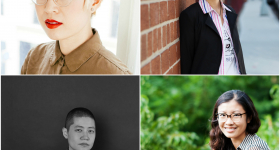In January, on a sunny San Francisco day, sound and performance artist Christine Sun Kim darts around the spacious nonprofit art gallery Southern Exposure (SOEX), giving directions and approving final installation decisions. Like the day before any exhibition, art preparators balance on ladders affixing blue ropes that cut across the sun-drenched space, and gallery staff busy themselves with last minute details. Though active, the gallery is unexpectedly quiet — everyone is scrawling messages to Kim on notepads or holding up text on their smartphones for her to view.
Now 33 years of age, Kim has been deaf since birth. She is fluent in American Sign Language (ASL), but she often uses a text app on her iPhone to communicate with the hearing and those who do not know ASL. When I arrive at SOEX, Kim quickly crouches down in front of her laptop, waves to me warmly and types, “WELCOME!!!!” in huge font for me to see. Kim’s eyes are wide and quizzical, emphasized by her dramatic round glasses and petite stature. She wears bright red lipstick framed by her black hair, which is severely cut with short, sharp bangs. Kim’s personality is similar — bold and assertive, but balanced by a warm and lively spirit.
Sitting side by side on a makeshift table, Kim and I take turns typing on my laptop in a Microsoft Word document. I don’t know ASL so traditional methods of conducting and recording an interview are out of the question. Kim explains that unlike some, “I don’t use voice as a tool to communicate. I just find it weird that I cannot hear myself and would need to rely upon others to teach me how to say words properly.”
Kim may not speak vocally, but she is far from quiet. She works a physical and touch keyboard with extraordinary swiftness. At times, she types faster than my thoughts can follow. Kim's use of her own body to create and communicate language is so efficient and elegant that my tortoise-paced fingers seem entirely conspicuous in comparison.
But this is what Kim does. In both her work and physical presence, she makes you aware of the apparatus of language and sound — how it is used or what form it takes. Her work often claims that sound is both privileged and a privilege. For Kim, sound and its language are not natural or normal, but a form and system that is learned and exchanged, but only by some.
Kim is in the final hours of a monthlong residency at SOEX, along with collaborators Stijn Schiffeleers and Shira Grabelsky, involving a closing performance, drawings and workshops. The residency also began with the joint creation of a single poem, titled “a real line ran near an ear,” which was constructed from words that could be created from the word "linear." Kim explains that the idea came to her when she “started telling [Schiffeleers and Grabelsky] about how ‘linear’ spoken and verbal English can be” compared to ASL. ASL has an entirely different grammatical structure than spoken English, much of which is embodied in the speakers' facial expressions and systems of classifiers rooted in hand form and movement. The poem was built from English but also from ASL, which is revealed by the focus on the words “index finger.” Kim describes that there are many styles or dialects of ASL, but the one she signs employs the index finger frequently. Kim’s work often breaks down and brings together different aspects of language to unfold the many layers involved in communicating.
Spend any time with Kim and you can tell that she thinks a lot about voice — not just speaking, but being heard. Even within collaborations, Kim explains that “because I’m deaf, it’s hard to keep my voice loud and clear. There’s a lot of incidental listening that occurs and a lot of small decisions that they [her collaborators] mindlessly make without asking me.”
Kim’s communication and expression have been quite a journey. She was born in Orange County, California, but her parents immigrated to the U.S. from Korea the year she was born. Both Kim and her older sister are deaf, and though they had a difficult time communicating with their parents, they were lucky to have one another. Her parents, who are hearing, did not speak English, Korean Sign Language or ASL when they immigrated to the U.S. So, her parents were learning to speak English as Kim and her sister were learning English and ASL. It wasn’t until they started to learn ASL on their own and through their friends that they all started to communicate better.
Kim, unsure why, admits she had more language struggles than her sister and that “it was always hard to articulate my feelings, thoughts and ideas. But it’s getting better now,” which she in part attributes to her art practice.
Kim has always been an artist in some way but she was a painter long before she “started employing sound in 2008. As soon as I found my ‘voice’ through sound (oh, the irony), my language acquisition became better. Art is like another language where I can truly, adequately and visually articulate.” Kim’s practice is a linguistic study, where sound and her body are both the medium and the content.
Kim often conducts and organizes groups of performers to make or enact the politics of sound. In “Coutier as Courier” (2013), Kim performed a voiceless lecture using multiple iPad and iTouch devices placed throughout the gallery. The audience would follow Kim around the room to various displays where she would swipe choreographed text combined with physical emphasis on using her body. Or in “Face Opera” (2013), Kim and a group of performers took turns conducting and acting in the “choir” of an opera of facial expressions led by prompts from an iPad. Kim suggests that the majority of ASL is actually expressed through the face and movement of the body, versus specific hand gestures. Kim’s work sometimes employs humorous exaggeration of physical movement, especially of the face, to reveal that communication is a complex layering of activity that the hearing often take for granted.
For her project at SOEX, Kim emphasizes that hearing and trusting are intimately bound together. For her, “so many people have fixed notions about silence and sound, and they can be deceiving. For example, I [think] it’s funny how when people hear rattling windows or swaying trees, they go ‘it’s so windy outside!’ as if wind is a sound. But you hear the result of wind. So I wanted us to figure out how to capture that idea in installation [and] performance.”
So Kim, along with Schiffeleers and Grabelsky, constructed a series of ropes that spread across the large, open gallery space both dissecting and connecting the distant walls and corners. Small metal rings were placed on the end of each cord, and during the performance, performers used poles to try to launch the rings from one end of the rope to the other. The sound of jingling rings, sometimes clanging manically with the force of the launch, echoed throughout the quiet space.
Nothing about the task is as simple as it seems. The performers struggle with the task of casting small rings — and their efforts are thwarted by ropes suspended high above the ground or awkwardly placed close to other ropes. Kim’s work emphasizes the labor expended in making sound that seems ordinary or unimportant. And watching them try is hilariously poignant. For Kim, sound has a physical presence and effect, even if she doesn’t make sense of it in the same way. Sound is not merely a sensory trigger, but evidence of social norms and systems in which people who are deaf seemingly have no place.
Kim can tell sound is present by how people act around her. She can see sound reflected in the movements and facial expressions of the hearing. For Kim, sound operates within a system of ownership which has rules she has learned to respect. The hearing are in command of sound — “turn your music down!” or “don’t be so loud!” or “it’s not your turn to speak!” Kim’s practice is her journey in transforming the rules of sound.
Christine Sun Kim is represented by Carroll/Fletcher, London, U.K.










Comments